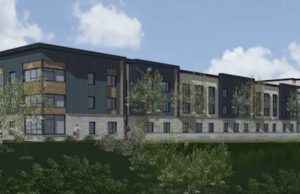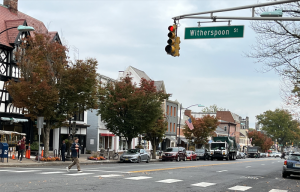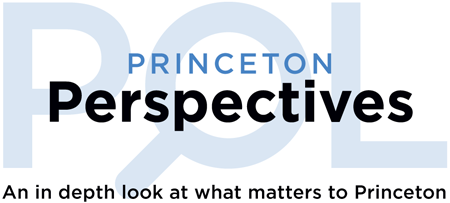 It would be hard to argue that recent municipal leadership has not been all in on efforts to create more affordable housing around Princeton. This creates opportunities where moderate, (defined as those making 50-80% of the Area Median Income for the area), low (those making below 50% of the median) and very low-income earners (those earning below 30% of the median income) can apply for housing and thereby afford to live in town. Qualifications for affordable housing are determined not only by income but also how many live in your household. In our region, for 2024, that max was anyone earning below $137,337 for 8+ person household and down to $72,830 for a single-person household. While most residents appreciate the economic diversity affordable housing brings, and admit more has been needed, some are raising concerns that simultaneous actions and decisions by local leaders are making the town unaffordable for others that already or seek to live here. It is a balancing act that can often be quite difficult but cannot be overlooked.
It would be hard to argue that recent municipal leadership has not been all in on efforts to create more affordable housing around Princeton. This creates opportunities where moderate, (defined as those making 50-80% of the Area Median Income for the area), low (those making below 50% of the median) and very low-income earners (those earning below 30% of the median income) can apply for housing and thereby afford to live in town. Qualifications for affordable housing are determined not only by income but also how many live in your household. In our region, for 2024, that max was anyone earning below $137,337 for 8+ person household and down to $72,830 for a single-person household. While most residents appreciate the economic diversity affordable housing brings, and admit more has been needed, some are raising concerns that simultaneous actions and decisions by local leaders are making the town unaffordable for others that already or seek to live here. It is a balancing act that can often be quite difficult but cannot be overlooked.
The majority of taxes are paid by higher-end homeowners, whose property taxes continue to increase. Many of their home values increase as well, but if their income levels change and they intend to stay in their homes and not sell, the tax increases can outpace many mortgage payments and become unaffordable. And what about the middle-income homeowners, is there enough housing for them to afford Princeton? Many affordable housing developments are tax-exempt, instead making an annual payment in lieu of taxes (PILOT). In some ways PILOTs may benefit Princeton as a whole, but individual taxpayers, at least in the short term, can bear the brunt.
AFFORDABLE HOUSING AND ITS HISTORICAL IMPACT
 As March 24th marked the 50-year anniversary of the Mount Laurel Decision, it is timely to reacquaint ourselves with what this means and how it’s led to today’s increased amounts of affordable housing. This landmark 1975 ruling by the New Jersey Supreme Court, provided that municipalities cannot have zoning that excludes lower income residents and mandated that every town in the state has an obligation to provide its fair share of affordable housing. That means each town/city must have a plan for creating living opportunities for lower-income earners, based on what the state determines is needed. It was not until the Fair Housing Act (FHA) was enacted in 1985 that Mount Laurel was implemented. FHA created Council on Affordable Housing (COAH) to oversee the rollout in New Jersey, and it did create two rounds of housing rules municipalities were to abide by.
As March 24th marked the 50-year anniversary of the Mount Laurel Decision, it is timely to reacquaint ourselves with what this means and how it’s led to today’s increased amounts of affordable housing. This landmark 1975 ruling by the New Jersey Supreme Court, provided that municipalities cannot have zoning that excludes lower income residents and mandated that every town in the state has an obligation to provide its fair share of affordable housing. That means each town/city must have a plan for creating living opportunities for lower-income earners, based on what the state determines is needed. It was not until the Fair Housing Act (FHA) was enacted in 1985 that Mount Laurel was implemented. FHA created Council on Affordable Housing (COAH) to oversee the rollout in New Jersey, and it did create two rounds of housing rules municipalities were to abide by.
But it was not operating efficiently, and many municipalities were still not providing enough affordable housing (and some wealthier towns were paying poorer towns to take on their obligations). So, in 2015, a new court decision demanded that everyone must truly do its part. That year the NJ Supreme Court ruled that lower courts would be given the power to ensure municipalities meet their fair share. It took another four years for Princeton to come to a settlement on how much housing would be required, at which point it got credit for some housing that had been built over the years and was mandated to create more. Princeton has since had to play catch up and meet its Third Round 2015-2025 mandate, resulting in what has often felt like a lot of development in a very short time. The municipality today has either had past-mandated affordable housing built or has locked in commitments to do so. Simultaneously, they are looking ahead to stay on top of the Fourth Round mandates which came out for 2025-2035.
Avalon Princeton Circle (at Thanet) and the adjacent Princeton Senior Living, The Alice, Avalon on Harrison and others have all recently been built. These contribute to meeting the needs in both municipal/grant/PILOT- funded all-affordable structures as well as private inclusionary ones (a mix of market rate and affordable units within the same building). Units on Nassau Street, Terhune Road and a development still to be built at the former Princeton Seminary site are amongst those that will additionally help Princeton meet its goals.
“Princeton’s Third Round prospective need affordable housing obligation was 753, and most of these units have now been built,” explains Council President Mia Sacks. “The town’s prospective need obligation for the Fourth Round is 276 — minus 25% for bonus credits — which means we must provide a realistic opportunity for 207 units to be constructed over the next ten years.”

Residences at Herrontown is the newest apartment complex offering affordable units in Princeton. The building, at the former SAVE animal shelter site, has 1, 2 and 3-bedrooms apartments which will include both market rate and affordable options. Owned/managed by affordable housing developer RPM LLC, it was partially built with a $2.5m municipal contribution and financing through the NJ Housing and Mortgage Financing Agency’s 9% tax credit program. Lottery applications are now being accepted for the 64 affordable units, open to low-income earners, people earning 50% or less of the Area Median income (2025s income limits are not out yet, but for 2024 this meant below $65,027 for a 4-person household). All those who submit eligible applications by 11pm on April 30th will be part of the random selection, and the Affordable Housing office can help you clarify your eligibility.
HOUSING THAT’S AFFORDABLE FOR ALL
Such options are an amazing opportunity for those with lower incomes that are new to the area or looking for a new place. It gives them a chance to be in Princeton in a brand-new apartment with a courtyard, playground, laundry and a clubhouse on site. While few are against such offerings, there are those that earn even just a little bit too much, that wish they had such opportunities as well. As previously mentioned, there have also been many buildings like this added into Princeton in just the past few years. Weichert Realtor Beatrice Bloom says she’s finding many clients who are aging or no longer have children at home and wish to leave their larger house and move into a 2 or 3-bedroom but are not finding options they find affordable amongst the new apartment units available to them (where market rate units often go for several thousand).
 “I work with many clients who are ready to downsize now that their kids are out of the house, but their options are super limited. Most of what’s available are small, expensive two-bedroom condos that don’t make financial sense compared to their current mortgages,” says Bloom.
“I work with many clients who are ready to downsize now that their kids are out of the house, but their options are super limited. Most of what’s available are small, expensive two-bedroom condos that don’t make financial sense compared to their current mortgages,” says Bloom.
Despite so many new units, such lack of lower-cost inventory can push residents, now on limited incomes or with an empty nest, out of Princeton. Simultaneously, these units bring in other residents that arrive with more school-age children. As was expressed in the proposal for the recent Princeton Public Schools (PPS) referendum, nearly 1,000 additional students are expected to come into the school system from the new apartment complexes over the next five years. This further strains an already squeezed district. To ameliorate things, a $89.9m bond referendum was approved in January. It will provide great funding for the schools, but the money will mostly be coming from homeowning taxpayers. Princeton is already by far the highest taxed municipality in Mercer County. Now, based on the tentatively approved school budget (final approval is April 29th), for the average assessed home in Princeton valued at $857,000, the referendum and 2025-2026 tax increase will add $433 annually to ones’ property bill. On top of that, there are both the municipal and county tax rates.
PROPETY TAX INCREASES
 At the March 10th Council Meeting, Princeton’s Chief Financial Officer Sandra Webb detailed the efforts that went into establishing the 2025 municipal budget. Tax increases were mitigated by things like $874,000 in reductions on department budgets, but with 43% of the overall monies needed for things the government has little control over, Webb explained there will still need to be a 3% increase.
At the March 10th Council Meeting, Princeton’s Chief Financial Officer Sandra Webb detailed the efforts that went into establishing the 2025 municipal budget. Tax increases were mitigated by things like $874,000 in reductions on department budgets, but with 43% of the overall monies needed for things the government has little control over, Webb explained there will still need to be a 3% increase.
“We are aggressive in reviewing proposed budgets and spending plans. To get to that we met with every department and reviewed their operating budgets line item by line item,” Princeton Mayor Mark Freda further explains. “Likewise for our 2025 capital budget requests we literally cut 50% of the requests out of the budget.”
After all of this, the budget was approved last night, April 14th. With the municipal part plus library costs, the average assessed home will see this portion of their taxes increase $134 this year. Added to the referendum increase, that is $567 more in taxes.
And then there is the third part of the property tax bill, the county line. On April 10th, Mercer County Executive Dan Benson presented his proposed budget to the Board of County Commissioners. This presentation offered a decrease in the overall tax rate by more than 6%. A decrease could surely make things more affordable! But such a proposal does not necessarily mean that county portion of your tax bill is going to be decreased.
“The County portion of the municipal tax rate cannot be finalized until the state certifies the budgets of each level of government and the towns determine any tax appeals or any changes in local ratable base. Even if the county equalized rate decreased, some municipalities may in fact see an increase and some may see a decrease based on the factors above. We expect to have these rates sometime after budget adoption.”
The County Commissioners will hold meetings and further discuss the budget before approving and finalizing any rates. Precisely what rate will be reflected in your Princeton tax bill is expected to be finalized in late May or early June. That will have to be added to Princeton’s municipal (plus library) portion and the school taxes, to provide an accurate overall property bill for the average assessed home for 2025.
“I’ve noticed more homeowners—even those buying at higher price points—are voicing concerns about taxes. This is especially true for people moving here from places with lower taxes or even just from nearby towns. A lot of folks were surprised that the 2024 school referendum passed since it was pretty aggressive, but at the same time, it’s exciting to think about what the town could look like in 20 years, especially with things like the Westminster property and other open spaces being preserved,” Bloom shares. “The big question now is: can Princeton grow in a way that balances equity, sustainability, and the needs of longtime residents—before the things that make it special start to push people out?”
HOMEOWNER CONCERNS
 One of those longtime Princeton residents is Gabriella Milley, who has lived in the same house for 20 years, over which she’s seen her taxes double. She welcomes affordable housing and wants Princeton Schools to continue to be strong and diverse. But Milley says at some point leadership is going to need to get more creative, especially with school needs, or many will not be able to afford to own or live here.
One of those longtime Princeton residents is Gabriella Milley, who has lived in the same house for 20 years, over which she’s seen her taxes double. She welcomes affordable housing and wants Princeton Schools to continue to be strong and diverse. But Milley says at some point leadership is going to need to get more creative, especially with school needs, or many will not be able to afford to own or live here.
“Why can’t part of the cost of these major improvements be covered via fundraising (the way private schools do it)? If a concerted effort was made to fundraise, much funding would come in the form of tax-deductible contributions (think appreciated stock) that would alleviate the amount needed to be raised via tax increases,” Milley suggests. “We need a problem-solving attitude by our town leaders, instead of the easy way out of simply increasing taxes on households.”
A Retirement Income Certified Planner, Milley works with older Princetonians. Many had thought they’d properly set themselves up for retirement by paying down their mortgages but have since found that their monthly tax burdens have grown so much it is as if they still had large mortgage payments. She and her clients are finding the formula for funding (our schools and taxes) is not sustainable.
“Their retirement benefits are not increasing as fast as their tax burden, or medical expenses, etc.,” Milley explains. “Some retirees are being forced to re-mortgage their homes so they can have some cash flow. Others are renting a room in their property to students so they can foot the bills.”
FINDING THE BALANCE
 It is rare, though not impossible, to see property tax bills go down. Will the County rate enable this to happen? What else needs to shift to make Princeton more affordable for all? Mayor Freda and Council have chosen to build the most recent affordable housing units at developers’ expense, to save taxpayers from funding them. But taxpayers are still responsible to pay towards the municipal and county budgets, as well as the school portion which made up 47% of last year’s tax bill.
It is rare, though not impossible, to see property tax bills go down. Will the County rate enable this to happen? What else needs to shift to make Princeton more affordable for all? Mayor Freda and Council have chosen to build the most recent affordable housing units at developers’ expense, to save taxpayers from funding them. But taxpayers are still responsible to pay towards the municipal and county budgets, as well as the school portion which made up 47% of last year’s tax bill.
There is no question that Princeton residents love the diversity of the people here, and it’s often a factor in why they chose to live here. It is for this reason most appreciate affordable housing opportunities that welcome those that otherwise would not be able to pay for a Princeton home. But what about the diversity of age, and long-term residents that are invested in their community? What about those middle-income-earners? Will Princeton’s affordability keep new families and others from moving in?
Some of the new affordable housing apartments and townhouses will enable seniors on fixed incomes to relocate in town. For others, who are not of qualifying age or whose income is still too high to qualify, time will tell if and how Princeton can maintain affordability for all.

Lisa Jacknow spent years working in national and local news in and around New York City before moving to Princeton. Working as both a TV producer and news reporter, Lisa came to this area to focus on the local news of Mercer County at WZBN-TV. In recent years, she got immersed in the Princeton community by serving leadership roles at local schools in addition to volunteering for other local non-profits. In her free time, Lisa loves to spend time with her family, play tennis, sing and play the piano. A graduate of the S. I. Newhouse School of Public Communications at Syracuse University, Lisa was raised just north of Boston, Massachusetts but has lived in the tri-state area since college. She is excited to be Editor and head writer for Princeton Perspectives!
